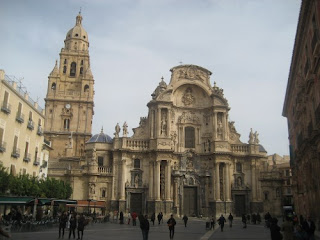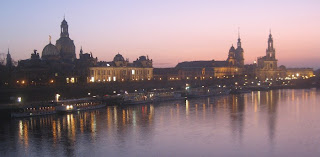During our travels whenever we spoke to other motorhomers who had been to Morocco they assured us “Oh, you must go! You'll love it!”. After a crossing in a rust bucket ferry that left two hours late, an arrival at a new port that was actually 40 or so kilometres outside Tangiers, and a hair-raising drive in the dark to a campsite that was invaded by a pack of barking wild dogs at night we were wondering what there was to love! Our first impressions were of a place that was chaotic, dirty, primitive and not very appealing. But at least it was warm and sunny.
However, a week or so later and a couple of hundred kilometres south of Tangiers we now understand what people meant. We've stayed in a couple of lovely, relaxing camp sites by the coast. In one the grass is kept short by a flock of sheep and a friendly horse.

We've visited the beautiful and quite hassle free cities of Rabat and Casablanca as well as smaller, more traditional towns, and we've strolled through markets full of the most beautiful handicrafts. We've eaten a tagine, developed a taste for mint tea, drunk a little Moroccan wine, and had fresh fish and vegetables sold to us at the van door. We've also worked out that the toll roads are well worth the money, and have had a go at using public transport. Oh, and it's still warm and sunny.

Christmas Day passed without any fuss at all. The German and French people on our campsite had obviously chosen to come to Morocco as they weren't big fans of Christmas, so the only signs of festive glitz were a couple of discreet mini Christmas trees on dashboards. No flashing lights, inflatable Santas or even German carols this year, quite different from last year's campsite in Spain. Strangely, when we were in Casablanca yesterday (the 29th Dec) there were a few Moroccan men dressed in Santa costumes giving sweets to children, and the checkout operators in the supermarket this morning were wearing Santa hats. We didn't ask, but we did wonder whether they have adopted some of the images of Christmas and applied them to New Year celebrations here. There are quite a lot of 'Bonne Année' signs about.
Some highlights so far:
- The Medinas of every town we've been to. All the term really seems to mean is the old town that was there before the French invaded. They are typically walled, traffic free, with a warren of crowded narrow streets and full of life and activity. They have a lot in common with the mediaeval 'Casco Historico' of almost any town in Spain, but in Morocco this is still where people live, trade and produce goods. In Tangiers they string coloured threads down an alleyway, so they can wind them into braid. In Rabat they fry fish on a burner on the back of a bicycle. You'll peer in through a doorway and see the diabolical figure of a baker tending a wood fired oven, a man at a sewing machine with a stack of part finished leather handbags, or racks of new clay pots drying.

- The Hassan Tower and Mohammed V Mausoleum in Rabat. Hassan Tower is the minaret of an unfinished mediaeval mosque, whereas Mohammed V's Mausoleum was built during the 1990s. They are both spectacular buildings, seeing them side by side emphasises the continuity between the mediaeval Moorish kingdoms and modern Morocco (and the tendency of Kings through the ages to want to show off). The part finished mosque is a lovely and extremely peaceful place to stroll around, used by locals as a park. The guards wear fabulous uniforms too.


- The ruins at Chellah in Rabat. It was scarcely given a mention in our guide book and didn't feature at all on the map we bought of Rabat, but for us it was a real highlight. It is the site of an ancient Roman city, redeveloped as a necropolis by later Muslim rulers. Today you can wander through gardens amongst part excavated Roman and Moorish ruins, enjoy great views and the clattering antics of dozens of pairs of storks nesting on the old buildings.

- Hassan II Mosque in Casablanca. It's one of only 2 mosques in Morocco that non Muslims can visit, the third largest mosque in the world, the highest minaret anywhere, lavishly decorated with carvings, tile work and marble, and quite spectacular. Sadly no-one except the King is allowed to see the glass floor over the ocean but we did get a tour of the ritual ablutions room, the prayer hall and the hamam (baths) in the basement

We're now getting quite used to the fact that you can drive through villages that look like a historical re-enactment of life from the Middle Ages, dodging horses and carts, donkeys, goats, cows, sheep, turkeys, small children and women carrying huge bundles of sticks but then arrive in a smart town that is like the cosmopolitan areas of a modern European city. The old traditions and modern innovations seem to coexist very happily here.

Having said all that, we're not forgetting that it is still early days. We've not yet strayed more than 20km from the Atlantic and we're still in the northern third of the Atlantic coastline (or the northern fifth, depending on what you think of the situation in Western Sahara). There's certainly a lot more to see.
Current location: a relaxed and slightly scruffy camp site full of French motor homes and well fed cats in El Jadida, an old Portuguese colonial town.
The Wine Blog Bit
We knew alcohol wasn't widely available in Morocco, but had trouble working out exactly what the rules were until we'd been here for over a week. Alcohol can't be sold unless you have a permit (like Britain, I suppose), but unlike Britain almost everyone is Muslim so alcohol is much more taboo. This has some strange effects:
- alcohol is only available (according to a Boulay Mousselham shopkeeper) in large towns and supermarkets. Shops in villages presumably don't bother applying for a license as no-one would want to buy it (or to be seen buying it).
- The boulevards of the colonial era districts all have large French style cafés with pavement terraces and dignified French style waiters with long black aprons. In France the mirrored wall behind the bar would be covered in shelves of bizarre French aperitifs, there'd be icy Kronenbourg or Jupiler on tap and a selection of wines by the glass. In Morocco the bar is bare, the drinks menu is only half a dozen items long, all the customers are drinking mint tea or some sort of coffee.
- During our first week in Morocco we didn't once see beer for sale, but noticed all the seafront carparks were somehow littered with crushed cans of 'Flag Special' as much as they would be in Britain.
- The alcohol section of the supermarkets is more or less like it would be in a British supermarket, with a decent selection of wine, beer and spirits … but strangely furtive. There's a special alcohol-only checkout where there's always a queue of Moroccan men staring at their shoes, waiting for the moment they can pay, put their purchases in an opaque bag and make a discrete exit through the side of the building.
- We've previously noticed that Moroccan wine (usually Boulaouane) is one of the few foreign wines commonly seen in French supermarkets, and wondered how the industry had survived in a mainly Muslim country. The supermarkets might have given us a clue; they have a wider selection of kosher wine than I've seen anywhere else, all produced in Morocco. As much as Islam hates wine, Judaism seems to love it, so maybe it's Morocco's Jewish minority that has kept the industry ticking over.
Imported wine is quite expensive, but domestic products are very reasonably priced. So far we can only report that Boulaouane Rosé is just as nice as it is from a French supermarket. We brought a bottle of Spanish cava with us (plus a bottle of Torres brandy) so we'll be seeing in the New Year with that.
Cheers everyone and Happy New Year!












































